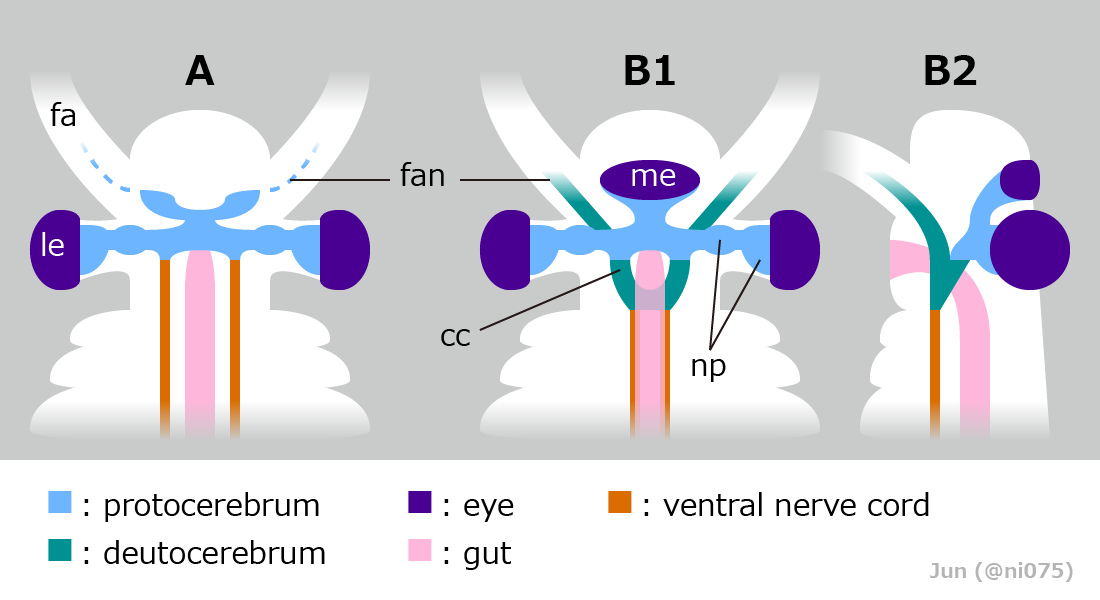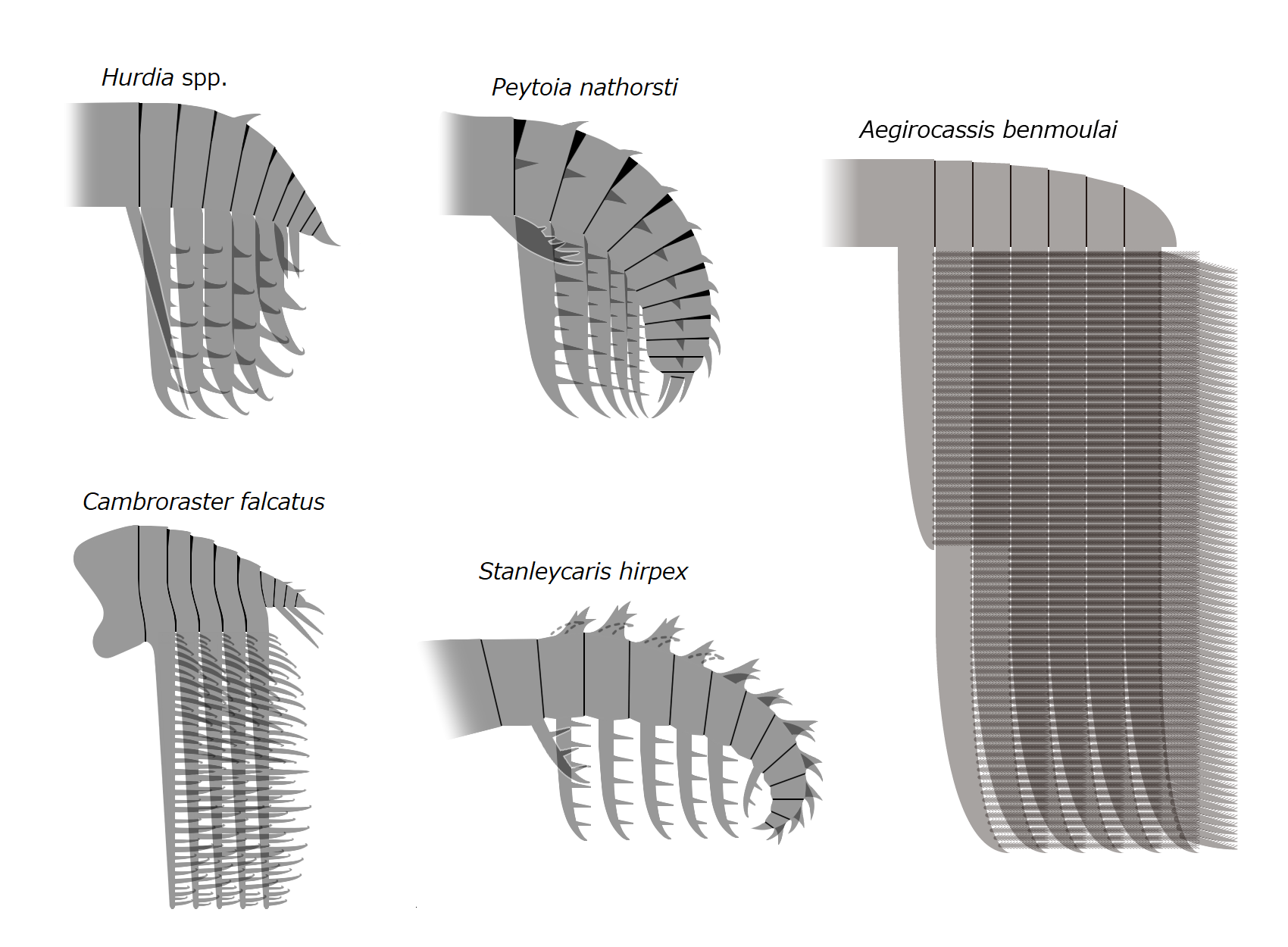|
Stanleycaris
''Stanleycaris'' is an extinct, monotypic genus of hurdiid radiodont from the middle Cambrian (Miaolingian). The type species is ''Stanleycaris hirpex''. ''Stanleycaris'' was described from the Stephen Formation near the Stanley Glacier and Burgess Shale locality of Canada, as well as Wheeler Formation of United States. The genus was characterized by the rake-like frontal appendages with robust inner spines. ''Stanleycaris'' was originally described only from frontal appendages and oral cone. However, in 2022, 268 specimens of ''Stanleycaris'', many of which were complete, were studied, making ''Stanleycaris'' a well documented radiodont. ''Stanleycaris'' had three eyes, a bizarre configuration previously unknown among other radiodont genera; yet this head anatomy supports early differentiation among arthropod head and trunk segmentation. The original description of the taxon appeared in an online supplement to the article published by Jean-Bernard Caron, Robert R. Gaines, ... [...More Info...] [...Related Items...] OR: [Wikipedia] [Google] [Baidu] |
Radiodonta
Radiodonta is an extinct order of stem-group arthropods that was successful worldwide during the Cambrian period. They may be referred to as radiodonts, radiodontans, radiodontids, anomalocarids, or anomalocaridids, although the last two originally refer to the family Anomalocarididae, which previously included all species of this order but is now restricted to only a few species. Radiodonts are distinguished by their distinctive frontal appendages, which are morphologically diverse and used for a variety of functions. Radiodonts included the earliest large predators known, but they also included sediment sifters and filter feeders. Some of the most famous species of radiodonts are the Cambrian taxa ''Anomalocaris canadensis'', ''Hurdia victoria'', '' Peytoia nathorsti'', '' Titanokorys gainessii, Cambroraster falcatus'' and '' Amplectobelua symbrachiata'', the Ordovician '' Aegirocassis benmoulai'' and the Devonian ''Schinderhannes bartelsi''. Etymology The name Radiodonta (Lat ... [...More Info...] [...Related Items...] OR: [Wikipedia] [Google] [Baidu] |
Radiodont
Radiodonta is an extinct order of stem-group arthropods that was successful worldwide during the Cambrian period. They may be referred to as radiodonts, radiodontans, radiodontids, anomalocarids, or anomalocaridids, although the last two originally refer to the family Anomalocarididae, which previously included all species of this order but is now restricted to only a few species. Radiodonts are distinguished by their distinctive frontal appendages, which are morphologically diverse and used for a variety of functions. Radiodonts included the earliest large predators known, but they also included sediment sifters and filter feeders. Some of the most famous species of radiodonts are the Cambrian taxa ''Anomalocaris canadensis'', ''Hurdia victoria'', '' Peytoia nathorsti'', '' Titanokorys gainessii, Cambroraster falcatus'' and '' Amplectobelua symbrachiata'', the Ordovician '' Aegirocassis benmoulai'' and the Devonian ''Schinderhannes bartelsi''. Etymology The name Radiodonta (Lati ... [...More Info...] [...Related Items...] OR: [Wikipedia] [Google] [Baidu] |
Hurdiid
Hurdiidae is an extinct cosmopolitan family of radiodonts, a group of stem-group arthropods, which lived during the Paleozoic Era. It is the most long-lived radiodont clade, lasting from the Cambrian period to the Devonian period. Description Hurdiidae is characterized by frontal appendages with distal region composed of 5 subequal blade-like endites, alongside the enlarged head carapaces and tetraradial mouthpart ( oral cone). The frontal appendages of hurdiids have a distinctive morphology, with the appendage of most species bearing five equally-sized elongate blade-like ventral spines known as endites. Subsequent podomeres were reduced in size and with only small endites or none. Each podomere bore only a single endite, unlike other radiodonts, in which the endites were paired. In most species, the endites were curved medially, so that the appendages formed a basket-like structure. Some hurdiids had greater numbers of endites, with '' Cordaticaris'' bearing seven ... [...More Info...] [...Related Items...] OR: [Wikipedia] [Google] [Baidu] |
Hurdiidae
Hurdiidae is an extinct cosmopolitan family of radiodonts, a group of stem-group arthropods, which lived during the Paleozoic Era. It is the most long-lived radiodont clade, lasting from the Cambrian period to the Devonian period. Description Hurdiidae is characterized by frontal appendages with distal region composed of 5 subequal blade-like endites, alongside the enlarged head carapaces and tetraradial mouthpart ( oral cone). The frontal appendages of hurdiids have a distinctive morphology, with the appendage of most species bearing five equally-sized elongate blade-like ventral spines known as endites. Subsequent podomeres were reduced in size and with only small endites or none. Each podomere bore only a single endite, unlike other radiodonts, in which the endites were paired. In most species, the endites were curved medially, so that the appendages formed a basket-like structure. Some hurdiids had greater numbers of endites, with '' Cordaticaris'' bearing seven e ... [...More Info...] [...Related Items...] OR: [Wikipedia] [Google] [Baidu] |
Wheeler Shale
The Wheeler Shale (named by Charles Walcott) is a Cambrian ( 507 Ma) fossil locality world-famous for prolific agnostid and '' Elrathia kingii'' trilobite remains (even though many areas are barren of fossils) and represents a Konzentrat-Lagerstätte. Varied soft bodied organisms are locally preserved, a fauna (including ''Naraoia'', '' Wiwaxia'' and '' Hallucigenia'') and preservation style ( carbonaceous film) normally associated with the more famous Burgess Shale. As such, the Wheeler Shale also represents a Konservat-Lagerstätten. Together with the Marjum Formation and lower Weeks Formation, the Wheeler Shale forms of limestone and shale exposed in one of the thickest, most fossiliferous and best exposed sequences of Middle Cambrian rocks in North America. At the type locality of Wheeler Amphitheater, House Range, Millard County, western Utah, the Wheeler Shale consists of a heterogeneous succession of highly calcareous shale, shaley limestone, mudstone and ... [...More Info...] [...Related Items...] OR: [Wikipedia] [Google] [Baidu] |
Stanley Glacier
The Stanley Glacier locality in British Columbia is an exposure of the "thin" Stephen formation exhibiting soft-tissue preservation. Fossils were discovered by a hiker who reported the find to Parks Canada; this brought the site to the attention of scientists who were able to study the site and describe the new biota. The discovery of Burgess Shale-type preservation in the thin Stephen was unexpected, given the absence of the Cathedral escarpment in the area. Several new species, including ''Stanleycaris ''Stanleycaris'' is an extinct, monotypic genus of hurdiid radiodont from the middle Cambrian (Miaolingian). The type species is ''Stanleycaris hirpex''. ''Stanleycaris'' was described from the Stephen Formation near the Stanley Glacier and Bu ...'', have already been found in exploratory excavations at the site. References Glaciers of British Columbia {{BritishColumbia-geo-stub ... [...More Info...] [...Related Items...] OR: [Wikipedia] [Google] [Baidu] |
Extinction
Extinction is the termination of a kind of organism or of a group of kinds (taxon), usually a species. The moment of extinction is generally considered to be the death of the last individual of the species, although the capacity to breed and recover may have been lost before this point. Because a species' potential range may be very large, determining this moment is difficult, and is usually done retrospectively. This difficulty leads to phenomena such as Lazarus taxa, where a species presumed extinct abruptly "reappears" (typically in the fossil record) after a period of apparent absence. More than 99% of all species that ever lived on Earth, amounting to over five billion species, are estimated to have died out. It is estimated that there are currently around 8.7 million species of eukaryote globally, and possibly many times more if microorganisms, like bacteria, are included. Notable extinct animal species include non-avian dinosaurs, saber-toothed cats, dodos, m ... [...More Info...] [...Related Items...] OR: [Wikipedia] [Google] [Baidu] |
Amplectobeluidae
''Amplectobeluidae'' is a clade of Cambrian Radiodonta, radiodonts. Definition In 2014, ''Amplectobeluidae'' was defined as the most inclusive clade including ''Amplectobelua, Amplectobelua symbrachiata'' but not ''Anomalocaris, Anomalocaris canadensis'', ''Tamisiocaris, Tamisiocaris borealis'', or ''Hurdia, Hurdia victoria''. Description Amplectobeluids could be recognized by frontal appendages with well-developed first distal endite, which forming a Chela (organ), pincer-like structure that presumably better suited for a grasping function. Complete body fossils of amplectobeluids are only known by ''Amplectobelua'' and ''Lyrarapax'', both showing combination of characters resembling ''Anomalocaris'' (i.e. streamlined body; small head with ovoid sclerites; well-developed swimming flaps; a pair of caudal furcae). Another distinctive features only known in amplectobeluid genera were pairs of gnathobase-like structures (known by ''Amplectobelua'' and ''Ramskoeldia''), or an oral ... [...More Info...] [...Related Items...] OR: [Wikipedia] [Google] [Baidu] |
20220715 Radiodonta Brain Interpretations
__NOTOC__ Year 715 ( DCCXV) was a common year starting on Tuesday (link will display the full calendar) of the Julian calendar. The denomination 715 for this year has been used since the early medieval period, when the Anno Domini calendar era became the prevalent method in Europe for naming years. Events By place Byzantine Empire * May – Emperor Anastasios II is deposed in an army mutiny, and succeeded by Theodosius III, a tax-collector from the ''theme'' of Opsikion (modern Turkey). After a six-month siege, Theodosius and his troops take Constantinople; Anastasios is forced to abdicate the throne, and retires to a monastery in Thessaloniki ( Macedonia). Europe * September 26 – Battle of Compiègne: Ragenfrid, mayor of the palace of Neustria and Burgundy (appointed by King Dagobert III), defeats Theudoald in the first battle of the Frankish civil war, following the death of Pepin II (of Herstal). * Dagobert III dies of an illness and is succeeded by ... [...More Info...] [...Related Items...] OR: [Wikipedia] [Google] [Baidu] |
Compound Eye
A compound eye is a visual organ found in arthropods such as insects and crustaceans. It may consist of thousands of ommatidia, which are tiny independent photoreception units that consist of a cornea, lens, and photoreceptor cells which distinguish brightness and color. The image perceived by this arthropod eye is a combination of inputs from the numerous ommatidia, which are oriented to point in slightly different directions. Compared with single-aperture eyes, compound eyes have poor image resolution; however, they possess a very large view angle and the ability to detect fast movement and, in some cases, the polarization of light. Because a compound eye is made up of a collection of ommatidia, each with its own lens, light will enter each ommatidium instead of using a single entrance point. The individual light receptors behind each lens are then turned on and off due to a series of changes in the light intensity during movement or when an object in moving, creating a fli ... [...More Info...] [...Related Items...] OR: [Wikipedia] [Google] [Baidu] |
Ommatidium
The compound eyes of arthropods like insects, crustaceans and millipedes are composed of units called ommatidia (singular: ommatidium). An ommatidium contains a cluster of photoreceptor cells surrounded by support cells and pigment cells. The outer part of the ommatidium is overlaid with a transparent cornea. Each ommatidium is innervated by one axon bundle (usually consisting of 6–9 axons, depending on the number of rhabdomeres) and provides the brain with one picture element. The brain forms an image from these independent picture elements. The number of ommatidia in the eye depends upon the type of arthropod and range from as low as 5 as in the Antarctic isopod ''Glyptonotus antarcticus'', or a handful in the primitive Zygentoma, to around 30,000 in larger Anisoptera dragonflies and some Sphingidae moths. Description Ommatidia are typically hexagonal in cross-section and approximately ten times longer than wide. The diameter is largest at the surface, tapering toward the in ... [...More Info...] [...Related Items...] OR: [Wikipedia] [Google] [Baidu] |
Peytoia
''Peytoia'' is a genus of hurdiid radiodont that lived in the Cambrian period, containing two species, ''Peytoia nathorsti'' from the Miaolingian of Canada and ''Peytoia infercambriensis'' from Poland, dating to Cambrian Stage 3. Its two frontal appendages had long bristle-like spines, it had no fan tail, and its short stalked eyes were behind its large head. 108 specimens of ''Peytoia'' are known from the Greater Phyllopod bed, where they comprise 0.21% of the community. ''Peytoia nathorsti'' and its junior synonym ''Laggania cambria'' played a major role in the discovery of the radiodont body plan. Initially interpreted as a jellyfish and a sea cucumber respectively, they were eventually shown to be the mouthparts and body of a single animal, which bore ''Anomalocaris''-like appendages. ''Peytoia infercambriensis'' is the geologically oldest known radiodont species. Classification ''Peytoia'' belongs to the clade Hurdiidae, and is closely related to the contemporary genu ... [...More Info...] [...Related Items...] OR: [Wikipedia] [Google] [Baidu] |





.jpg)


